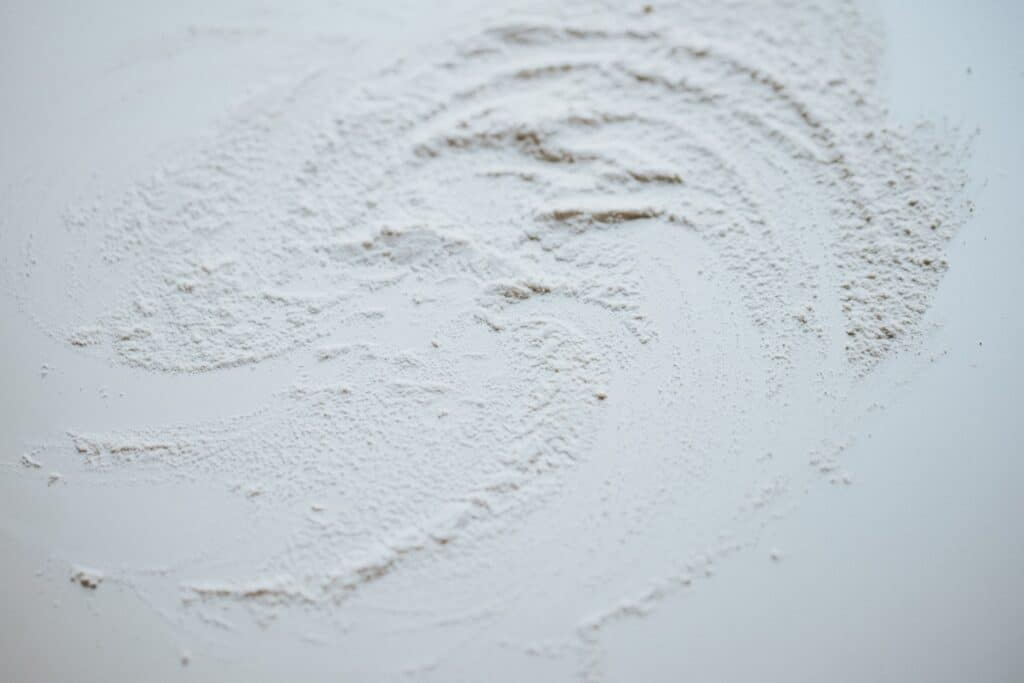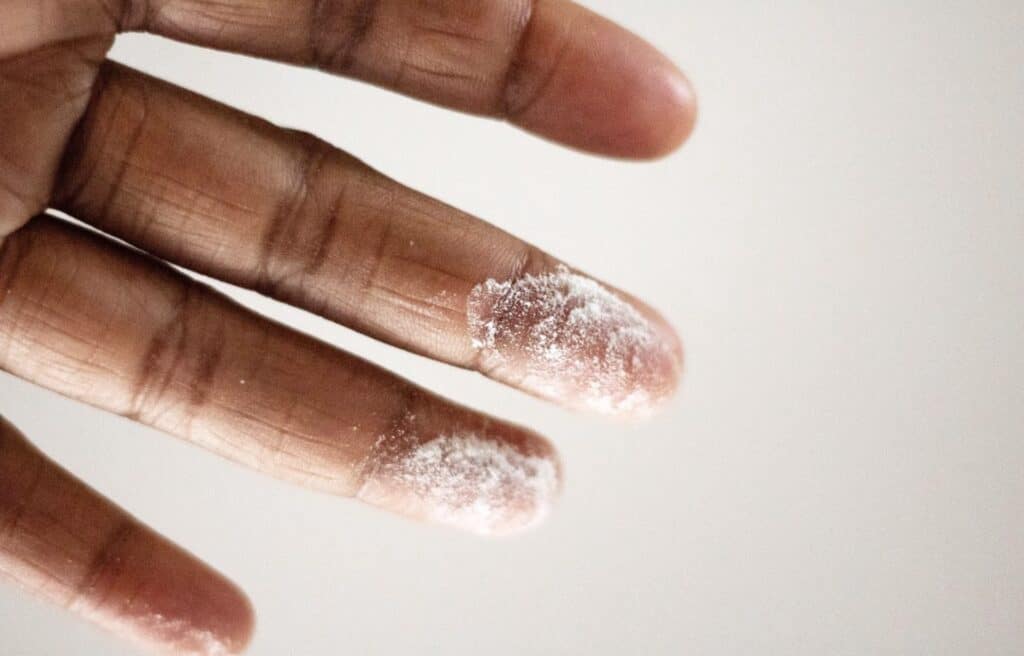Talcum powder is a common product used in many American households for a variety of purposes, including the prevention of diaper rash and personal care needs. However, it’s important to be aware of potential health risks associated with its use. If talcum powder is inhaled, it can potentially harm your lungs. Moreover, it has been associated with an increased risk of certain types of cancer. To safeguard your health and the wellbeing of your family, you might consider using an alternative that does not contain talc, such as cornstarch baby powder.
For decades, countless individuals have used talc powder on both themselves and their babies. It’s used to prevent chafing, absorb moisture, and maintain a fresh scent. However, this common product time may not be as safe as people think.
Baby powder, especially when used on toddlers and babies, can present significant health risks. If young children accidentally inhale or consume the powder, it can cause serious complications. Moreover, an increasing number of scientific studies are associating talc with a couple types of cancer—namely ovarian cancer and lung cancer. This potential connection to serious health issues underlines the importance of being informed and cautious about the products we use on ourselves and our loved ones.
What is Talcum Powder?
Talc, a naturally-occuring mineral found in the earth, is made up of elements like magnesium, silicon, and oxygen, mixed with a bit of water. It is extracted through mining, after which it is pressed into a light powder—the talcum powder we most often think of.
One of the key characteristics of talc is that it’s smooth and soft, and it has the ability to hold onto scents. This makes it a beneficial ingredient in many cosmetic products and talc based baby powder, like Johnson’s Baby Powder.
However, there are potential risks linked with the use of talc. Because talc and asbestos, a known carcinogen, can naturally occur close to each other in the ground, there’s a chance that talc could be contaminated with asbestos. While cosmetic talcum powder, which is the most purified version of the mineral, is intended to be asbestos free, tests have sometimes detected small amounts of asbestos in talc products, including baby powder and other talc-containing cosmetics. This is a concern due to the health risks, particularly lung cancer and mesothelioma, associated with asbestos exposure.
What Products Use Talcum Powder?
Baby powder is perhaps the most recognized talc-based product on the market, however, talc is also a popular ingredient in a wide range of cosmetics. This includes items like blush, eye shadow, face powders, and foundation.
Talc’s role in cosmetics is multifaceted. It absorbs moisture, gives makeup a smooth and silky texture that makes it easier to apply, prevents the formation of clumps, and contributes to its opacity. Beyond cosmetics, talc is frequently used in personal care items, such as deodorants and dry shampoos.
Moreover, talc is utilized in medications and several food products, such as candy, rice, and chewing gum. When ingested through food, talc is generally considered safe, as it travels through the digestive tract without being absorbed.
In addition to its presence in cosmetics and food, talc has numerous industrial applications. It is incorporated in diverse products, from caulks to asphalt shingles, paint, sealants, and more. Its wide use underscores its versatility while also highlighting the need for careful monitoring to prevent asbestos contaminated talcum powder.

Who Regulates Talc Products in the United States?
The U.S. Food and Drug Administration (FDA) doesn’t directly conduct safety tests on talc or talcum based products before they are sold in stores. It also hasn’t established a limit for asbestos contamination in cosmetic talc.
Instead, manufacturers of talc based products, including baby powder and other cosmetic products, rely on safety assessments and guidelines provided by the Cosmetic Ingredient Review (CIR) panel. This panel is led by the industry itself, which means that cosmetic manufacturers are responsible for policing their own products.
However, the FDA does keep an eye on potential safety issues with personal care products, including talc products, and will step in if necessary. For instance, in response to safety concerns about possible asbestos contamination in 2009, the FDA examined cosmetic talc sourced from several suppliers.
Additionally, the FDA investigated talc-based cosmetic products that were purchased from retail stores. Although they did not find asbestos during their review, they noted that their investigation had a limited scope, and therefore could not conclusively prove that all or most talc products sold in America are asbestos-free.
Is Talcum Powder Safe for Infants?
Contrary to what its name might suggest, baby powder can potentially be dangerous to babies and young children. When you dust a child with talcum powder, it can create a large cloud of powder. If an infant accidentally inhales this talc dust, they may experience serious breathing problems and other health problems.
Because of these risks, many pediatricians advise against using baby powder on children.
Talcum powder inhalation can lead to respiratory symptoms like coughing, chest pain, wheezing, difficulty breathing.
According to the National Institutes of Health, other symptoms of talc poisoning can include:
- Throat and eye irritation
- Lethargy
- Reduced urination
- Weakness
- Cardiovascular collapse or low blood pressure
- Seizures
- Face, arm or leg twitching
- Blisters
- Coma
- Vomiting and diarrhea
- Blue lips, fingernails, and skin
While it is rare, talc inhalation can lead to fatal consequences for a child. If a child exhibits any symptoms or signs of talc poisoning, immediately move them to an area with fresh airflow and call for medical assistance. Poison Control can be reached at 1-800-222-1222, and is an important resource in such situations.
How to Protect Children from Talc
- Consider using cornstarch baby powder as a safer alternative to talcum based powder.
- Always store powder in a place where it is inaccessible to children.
- To prevent inhalation, do not use the powder near the child’s face.
- Instead of applying powder directly on your baby, put it on your hands at a safe distance away from your child, then apply it to their skin.
- Use powder infrequently and in moderation.
- Avoid using talcum powder on wounded skin.
- Refrain from using any kind of powder on babies who have lung problems or are born premature.
- For treating diaper rash, consider using drugstore ointments and creams as an alternative.
Talc Health Risks
Talcum powder is associated with lung issues in adults, as well as a couple different cancer types. Numerous studies have indicated that women who used talcum powder on their genital region as part of their feminine hygiene practices may have a higher risk of being diagnosed with ovarian cancer.
Additional research has associated the continuing use of talcum powder with a rare, deadly cancer known as mesothelioma. This disease damages the linings of the abdomen, lungs, and other organs. Several mesothelioma patients have filed a talc lawsuit against talcum powder companies, and have either received settlements or won substantial awards.
The connection between ovarian cancer and talc use remains a contentious topic. Thousands of lawsuits have been filed against Johnson & Johnson and other talc manufacturers. Some of these talcum powder lawsuits have led to record verdicts.
In response to declining sales and the increasing number of baby powder lawsuits, Johnson & Johnson announced in mid 2022 that they would cease production of their popular talc-based baby powder by 2023. However, the company maintains that this decision is driven purely by financial considerations, and insists their talc based baby powder is free from asbestos and does not contribute to cancer development.

Inhalation of Talcum Powder: Talcosis
Another potential health risk associated with the inhalation of talc is a severe lung inflammation condition known as pulmonary talcosis.
This condition was first identified several decades ago among employees in the talc mining industry. These workers were exposed to high levels of talc particles for prolonged periods of time. However, medical case reports indicate that long-term inhalation of cosmetic talc, including baby powder, can also lead to talcosis.
For instance, a 2018 report in the Journal of the Belgian Society of Radiology detailed a case involving a woman who was diagnosed with talcosis after she used large amounts of cosmetic talc daily for many years. Her primary symptoms were joint pain and shortness of breath. CT scans revealed several irregular growths and signs of inflammation in the lungs.
Talcosis symptoms can vary greatly. Some people may be asymptomatic, while others may experience respiratory failure. Symptoms can include dyspnea (a worsening shortness of breath over time), and some people have a dry cough.
Sadly, a diagnosis isn’t always straightforward. According to medical reports, complete talcosis can take years to manifest. It may even develop several years after someone has stopped talcum powder use.
The BMJ published a report in 2011 that details a woman who was diagnosed with talcosis a decade after she stopped a 4-month habit of smelling cosmetic talcum powder. According to authors of the report, the possible time gap between exposure and diagnosis may result in a large number of talcosis cases being misdiagnosed.
Fact: The first recorded instance of talcosis, also referred to as “talc lung,” dates back to 1896. Since that time, medical literature has documented more than a handful of similar cases.
Should I Stop Using Baby Powder?
While the U.S. National Toxicology Program has yet to conclude its evaluation of cosmetic talc as a potential carcinogen; other nations are considering implementing stricter regulations for mineral talc.
For instance, Canada’s government is contemplating adding talc to its toxic ingredients list while also limiting its use in consumer goods that can be inhaled or applied near the genital area. Draft regulations issued suggest that using a talc based product near the genitals may increase the risk of ovarian cancer and other reproductive cancers.
To reduce talc exposure, Health Canada provides several recommendations for consumers:
- Do not inhale talcum powder
- Refrain from applying talcum powder near reproductive organs
- Opt for a talc-free alternative.
Additionally, the American Cancer Society suggests that people who have concerns about talcum powder should limit or avoid using talc based products until further information becomes available.
Talc Alternatives
Cornstarch products share a similar texture with talc, possess similar absorbent properties, and can even retain the classic baby powder smell. Other powder alternatives may include a mix of ingredients, such as baking soda, kaolin, rice powder, arrowroot powder, and other organic ingredients.
A few well-known brands that offer talcum powder substitutes are:
- Era Organic’s Talc-Free Baby Dusting Powder
- Burt’s Bees Baby Dusting Powder
- Johnson’s Cornstarch Baby Powder with Aloe & Vitamin E
- California Baby Calming Organic Powder
You can also create a baby powder substitute by using one of the many recipes found online. Regardless of the alternative you select, it’s still important to refrain from using powder near an infant’s face.
An increasing number of cosmetic companies are also providing talc-free products. For example, Omiana Cosmetics exclusively sells makeup that is talc free, and Cover FX’s line is free from five contentious ingredients: talc, mineral oil, parabens, gluten, and fragrance.
Whenever you choose a product, it’s important to review the ingredient label. If you’re unfamiliar with a product or its ingredients, you can search for it on the Environmental Working Group’s Skin Deep Cosmetics database. This database contains thousands of products, and provides detailed information on the safety of their ingredients. Each product in the database is given a score from 1 to 10, with 1 being the safest and 10 having the highest health risk. The scores are based on a comprehensive review of the scientific literature, and include links to the original sources so users can investigate the evidence themselves.
References
- https://academic.oup.com/qjmed/article/105/8/795/1563653
- https://err.ersjournals.com/content/19/116/165
- https://www.cancer.org/cancer/cancer-causes/talcum-powder-and-cancer.html
- https://www.cbc.ca/news/health/talcum-powder-may-be-harmful-to-lungs-health-canada-1.4933506
- https://www.cdc.gov/niosh/pgms/worknotify/talc.html
- https://www.canada.ca/en/health-canada/services/chemicals-product-safety/talc.html
- https://www.ewg.org/skindeep/ingredients/706427-TALC/
- https://www.fda.gov/about-fda/commissioners-fellowship-program/nakissa-sadrieh-phd-2017
- https://www.fda.gov/cosmetics/cosmetic-ingredients/talc
- https://www.foodprocessing.com.au/content/food-design-research/news/talc-use-in-food-processing-a-health-hazard-say-researchers-859641872
- https://www.jbsr.be/articles/10.5334/jbsr.1384/
- https://www.jnj.com/johnson-johnson-consumer-health-to-transition-global-baby-powder-portfolio-to-cornstarch
- https://www.lebonheur.org/blogs/practical-parenting/is-baby-powder-dangerous/
- https://www.ncbi.nlm.nih.gov/pmc/articles/PMC3185388/
- https://medlineplus.gov/ency/article/002719.htm
- https://pediatrics.aappublications.org/content/68/2/265
- https://pubs.usgs.gov/fs/fs-0065-00/fs-0065-00textonly.pdf
- https://www.thestar.com/business/2017/05/05/woman-awarded-record-110m-in-baby-powder-lawsuit.html
- https://www3.epa.gov/ttnchie1/ap42/ch11/final/c11s26.pdf
